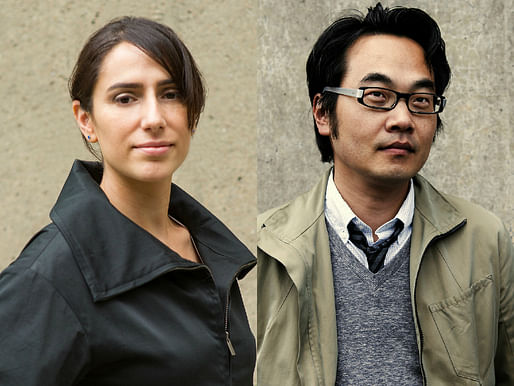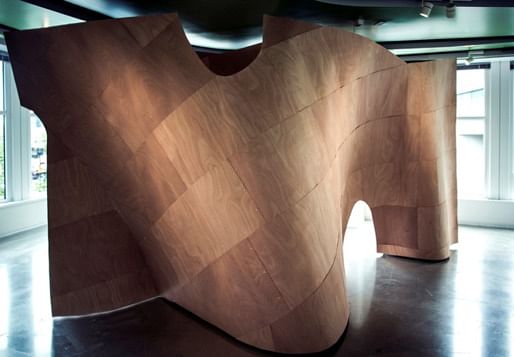

Last week, Modelo visited IK Studio’s principals Mariana Ibañez and Simon Kim at their Cambridge office. Ibañez and Kim run the six-person architecture and design firm together both in Cambridge and Philadelphia where they are involved as both practicing architects and educators at Harvard GSD and University of Pennsylvania School of Design. Mariana and Simon were gracious enough to answer our questions thoughtfully and completely, so we’ve broken their interview into a two-part post. Please be sure to follow up for part two next week!
Simon Kim is an assistant professor at the University of Pennsylvania School of Design and a director of the Immersive Kinematics Lab. He is also a licensed architect and principal of IK Studio.
Mariana Ibañez is an associate professor at Harvard University Graduate School of Design, member of the Geometry Lab and Responsive Environments lab, and principal of IK Studio.
On their beginnings:
MI: We met in London at the Architectural Association when we were students of the Design Research Lab getting our master’s degrees. After graduation, Simon went on to work for Zaha Hadid’s office and I worked for Cecil Balmond when he was directing the Advanced Geometry Unit at Arup, and then I joined Zaha’s office as well. The polemics and ideas that would shape IK Studio started when we moved to the US in 2006. Simon went to MIT for his research and I started teaching at the GSD, so we were both doing projects that were research oriented. IK Studio was officially born last year (2014).
SK: We established IK Studio the year we received our permanent residencies in the US. Prior to that we were teaching and performing research at our respective institutions.
MI: That time gave us a chance to work in a very experimental manner because all the work was framed in relationship to our academic pursuits, more or less directly. It was interesting because we realized that isn’t an aspect of the practice we’ll ever want to lose as we return to buildings or architecture with a capital “A”. That part of the work really forms how we think about architecture and it also allows us to develop projects that are their own and have their own agendas, their own methodologies, and their own goals within the practice that are purely research or experimentation.

Photo by Kordae Jatafa Henry
On the goals of IK Studio:
SK: It’s a two-fold practice: one is the augmented, or the totally experimental, which we call architecture as well as the commercial, and the other is for-profit work that is also more traditionally seen as architecture. We claim both sides and we don’t punish one for the other. The way that we work is through the experimental work that we’re calling our “conceptual project” from which we draw results to form the work that will become buildings and cities and landscape. The reason why we do this is because without the underlying project, it’s difficult to frame what’s future-forward. The things we do in terms of robotics, the interaction, the immersive — it’s really important that we have that critical position within architecture.
On their division of responsibility:
MI: We’re trying different models as we’re growing, to see what works. For example, we talk about having one principal leading a project and the other gives feedback, or in some projects one will take the lead on the design and the other one on fabrication and construction. We’re testing things that we learned from previous experiences working for others. For now, it’s a little bit fluid.
I feel lucky to be part of all these transitional moments. To have transitions or even opposites as a means to reconcile all those extremes posed as questions on how to make things or even how to ask questions.
On their greatest influences:
SK: I’ll tell you whose work we like and then I’ll tell you whose relationships we like as husband and wife in terms of teams. Let’s start with the second one first. The Eames (Ray and Charles); I think they’re amazing in terms of their large body of work from the small to the planetary in scope. They were very influential. There’s also a smaller group: Dunne and Raby. They are industrial designers / critics of product design based in London. In terms of whose work we like regardless of who they are, Zaha (Hadid) and Frank (Gehry) will always be pretty big since we’ve worked at their offices and for what they’ve brought to the discipline.
MI: Going to the first point, I think we look a lot at husband and wife teams to see how their offices are structured and the work that they do. If they last… things like that. I would add to that list Mack Scogin and Merrill Elam. Asymptote, too. In our generation, a lot of our friends practice as spouse teams, so we suspect it’s a viable model. In terms of references, for me, Zaha was influential in my formative years as well as my professional years. Between the two of us, this may vary a bit: my college education was in a school I think still is somehow a response to the modernist traditions of South America. It’s a polytechnic school with all that implies. Then my graduate studies were at the AA where I purposefully looked for a very experimental, pushing-the-boundaries type of education. Also because of our age, we’re both pre-digital and post-digital – whatever that means in terms of tools and methodologies. I feel lucky to be part of all of these transitional moments. Our life experiences, having lived in different places, shows that the life of an architect in America is very different than in Europe or Latin America — there are completely different forms of practice.
Right now we’re in a time where industry is really driving a lot of innovation, and it’s good when you can be a part of both. What you discuss in academia is not necessarily the way you discuss in practice.

Photo by Kordae Jatafa Henry
On the relationship between teaching and practice:
SK: There is a tricky question right now in terms of the meaning of research and design. A lot of people are applying definitions to fill this gap and we question it all the time. When you have something you pretend is a scientific method that produces results, you want to know it’s quantifiable, predictable, and can be scaled, or put to bear somewhere else. As a designer, I know that to be fundamentally weird because the ways in which we design, for me, should always have inventiveness and innovation but also bring about cultural relevancy and some sort of fresh social outlook that isn’t locked into some formula to be played out item-for-item. For me, it’s a terrible scenario to play it out in a game of numbers. So we’re designing in a way that we don’t necessarily research at school. Yes, I do perform research to produce papers I publish and put out there, but when we design, it’s not to indoctrinate the future of everyone or to build upon some kind of ad hoc proto-scientific method.
MI: I always believed in the dual-model: the teaching-practicing model. I always felt comfortable or always desired to be part of both worlds. They both have their own characteristics. I don’t think you have freedom in academia and then constraints in practice — academia has its own constraints and practice has its own freedoms. I’m interested in maintaining those two. Looking at that question historically, there are moments in time where the innovation in the architecture field is driven by academic investigations. New things emerge from the academic world. Right now we’re in a time where industry is really driving a lot of innovation, and it’s good when you can be a part of both. What you discuss in academia is not necessarily the way you discuss in practice. For me, it’s always good to learn from both, but at the same time, keeping them in separate domains allows me to enjoy the benefits of both environments. I would always want to teach and practice. I don’t know if I can do just one or the other.
On the tools and programs they use:
SK: The last project was this giant poly-ball, but its faces are developed into cones. So you have the fourteen cones making a cuboctahedron and they have the shared edges where they meet. To create that, we used a lot of Rhino. We also use Maya a lot… Maya is just fantastic in terms of conceptual modeling and quick sketching. Rhino is when you want to become precise; it’s great for fabrication files. We also design a lot of interaction. We were using Arduino and also Processing — those were the platforms for that particular project. We also use a lot of other software platforms as needed such as SolidWorks.

Photo by Kordae Jatafa Henry
MI: Many of the people in the office commonly use Grasshopper and related plug-ins — that’s their method of coding. We’re also using more traditional programs, from AutoCAD to the Adobe Suite. Most of the 3D modeling happens between Maya and Rhino.
On current limitations of design software:
MI: Starting with a little bit of history, when we first learned how to code we would use Flash and also would code within Maya. Now, with graphic coding systems like Grasshopper, I don’t think people are necessarily learning programming anymore. Some things are very easy to do. On the other side, with some of the other projects, for example the ones where we were bending plywood, it’s the opposite. We’re usually focused on trying to build our digital models accurately. But for certain types of projects we find, we can never find an accurate digital model because the knowledge comes from the material behavior and that’s not necessarily something we can simulate. So where would I like to see this evolving? Having an easier way to simulate material behaviors, like bending plywood, and integrating that into the software platforms we use in the office. Now, we have certain projects where the prototypes and digital models doesn’t match. And because we are very interested in physical computing, a lot of our projects navigate the relationship between analog behavior and digital behavior. I think whether it goes in one direction or the other, we find that depending on the project where one side is always more precise than the other is a strange zone. So to have those two being equal would be fantastic.
At Modelo we want to know what drives the world’s design and architecture talent. This is why we invite select architects and designers to share their stories, philosophies, visions and favorite works with the public — their manifestos. For more information on how we're working to change the architecture and design world at Modelo please visit us at: www.modelo.io.
No Comments
Block this user
Are you sure you want to block this user and hide all related comments throughout the site?
Archinect
This is your first comment on Archinect. Your comment will be visible once approved.